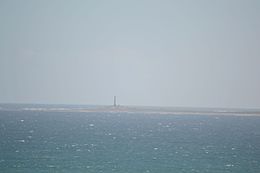Native name: Dasseneiland | |
|---|---|
 Dassen Island and lighthouse, 9 km (6 mi) off the coast of Yzerfontein | |
 | |
| Geography | |
| Coordinates | 33°25′24″S 18°05′14″E / 33.423402°S 18.087127°E |
| Area | 2.60 km2 (1.00 sq mi) |
| Administration | |
| Demographics | |
| Population | 0 (2011)[1] |
| Official name | Dassen Island Nature Reserve |
| Designated | 29 March 2019 |
| Reference no. | 2383[2] |
Dassen Island is an uninhabited South African island in the Atlantic Ocean. It is situated about 10 km (6 mi) west of Yzerfontein and 55 km (34 mi) north of Cape Town. The flat and low-lying island measures about 3.1 km (1.9 mi) long northwest–southeast and 1 km (0.6 mi) wide, with an area of 2.73 km2 (1.05 sq mi).[3] It is a proclaimed nature reserve.
In Dutch "das", the plural being "dassen", is a badger (Meles meles). In Dutch/Afrikaans the word "dassie" means "rock-hyrax" or "rock-badger" and the island is named after the colonies of hyraxes (Procavia capensis) encountered there by the discoverers. Named Ilha Branca ('white island') by the early Portuguese mariners, it was renamed Elizabeth Eiland by Joris van Spilbergen in 1601. The form Dasseneiland (Dutch/Afrikaans) is preferred for official purposes.[4] It was also occasionally referred to as Penguin Island.[5]
The island is underpinned by a fine-grained tourmaline granite, with a few zones of biotite granite. The intrusive rocks (late Precambrian) are in part covered by sand. Along much of the shoreline large, rounded boulders protrude from the sand to heights just above the high water mark. Although temporary pans form during the wet season (winter) in the interior, there is in general little fresh water on the island.
Except on its eastern side, Dassen Island is surrounded by reefs. Many ships have been shipwrecked here.
- ^ "Main Place "Dassen Island"". Census 2011. Retrieved 29 August 2013.
- ^ "Dassen Island Nature Reserve". Ramsar Sites Information Service. Retrieved 10 September 2019.
- ^ "Avian Demography Unit: Dassen Island". Archived from the original on 27 May 2012. Retrieved 13 March 2010.
- ^ Raper, Peter E. (1987). Dictionary of Southern African Place Names. Internet Archive. p. 130. Retrieved 28 August 2013.
- ^ "Penguin Isle preferred (Dassen Island, 1956)". The Morning Call. 21 February 1956. p. 5. Retrieved 9 May 2020.
